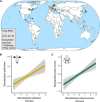A global synthesis reveals biodiversity-mediated benefits for crop production
- PMID: 31663019
- PMCID: PMC6795509
- DOI: 10.1126/sciadv.aax0121
A global synthesis reveals biodiversity-mediated benefits for crop production
Abstract
Human land use threatens global biodiversity and compromises multiple ecosystem functions critical to food production. Whether crop yield-related ecosystem services can be maintained by a few dominant species or rely on high richness remains unclear. Using a global database from 89 studies (with 1475 locations), we partition the relative importance of species richness, abundance, and dominance for pollination; biological pest control; and final yields in the context of ongoing land-use change. Pollinator and enemy richness directly supported ecosystem services in addition to and independent of abundance and dominance. Up to 50% of the negative effects of landscape simplification on ecosystem services was due to richness losses of service-providing organisms, with negative consequences for crop yields. Maintaining the biodiversity of ecosystem service providers is therefore vital to sustain the flow of key agroecosystem benefits to society.
Copyright © 2019 The Authors, some rights reserved; exclusive licensee American Association for the Advancement of Science. No claim to original U.S. Government Works. Distributed under a Creative Commons Attribution NonCommercial License 4.0 (CC BY-NC).
Figures




References
-
- Díaz S., Pascual U., Stenseke M., Martín-López B., Watson R. T., Molnár Z., Hill R., Chan K. M. A., Baste I. A., Brauman K. A., Polasky S., Church A., Lonsdale M., Larigauderie A., Leadley P. W., van Oudenhoven A. P. E., van der Plaat F., Schröter M., Lavorel S., Aumeeruddy-Thomas Y., Bukvareva E., Davies K., Demissew S., Erpul G., Failler P., Guerra C. A., Hewitt C. L., Keune H., Lindley S., Shirayama Y., Assessing nature’s contributions to people. Science 359, 270–272 (2018). - PubMed
-
- S. Díaz, J. Settele, E. Brondízio, Summary for policymakers of the global assessment report on biodiversity and ecosystem services of the Intergovernmental Science-Policy Platform on Biodiversity and Ecosystem Services (United Nations Paris, Fr., 2019), 1–39.
-
- Naeem S., Duffy J. E., Zavaleta E., The functions of biological diversity in an age of extinction. Science 336, 1401–1406 (2012). - PubMed
-
- Tilman D., Isbell F., Cowles J. M., Biodiversity and ecosystem functioning. Annu. Rev. Ecol. Evol. Syst. 45, 471–493 (2014).
-
- Cardinale B. J., Duffy J. E., Gonzalez A., Hooper D. U., Perrings C., Venail P., Narwani A., Mace G. M., Tilman D., Wardle D. A., Kinzig A. P., Daily G. C., Loreau M., Grace J. B., Larigauderie A., Srivastava D. S., Naeem S., Biodiversity loss and its impact on humanity. Nature 486, 59–67 (2012). - PubMed

